Porcelain Insulator News
by Jack H. Tod
Reprinted from "INSULATORS - Crown Jewels of the Wire", April 1977, page 23
Dear Jack:
Wanted to drop you a quick sketch and get any info I could on a U-432A I
found recently. There is a circular (almost oval) marking on the underside of
the skirt with no apparent mark inside the circle.
The most interesting thing is that the 4 threads are segmented. There are 4
sections of threads. Would appreciate any comments.
Dr. Jon McIntire,
Harrisonburg, Va.
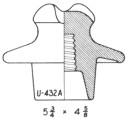
- - - - - - - - -
Dear Jon:
Many of these particular insulator styles have various factory markings under
the skirt, about like yours. In fact, the majority do. It's usually just a
single letter (A, R, W, etc.) in fairly large type. I can't see why collectors
should attribute any significance to these production markings, but it can't be
denied that everyone's curiosity is aroused by them; I've had numerous questions
about them in past years.
As explained in my book, I thought these segmented threads resulted from the
use of fluted trimming machine spindles for these styles. The theory was that
the fluted spindles gave better traction on these heavier units and eliminated
slippage. Needless to say, I was just groping for an explanation of this, and
more evidence since I originally stated my thoughts has poured cold water onto
the theory.
Although I've seen the segmented threads on at least one other style (a
feeder cable type), this has usually concerned only these U-432 and Similar
styles. If my theory on fluted trimmer spindles were correct, segmented threads
would appear on a host of other styles also.
What's more, the comparable glazewelded style U-958 (and Similar ones) also
come with segmented threads, and the small internal piece of these insulators
required no trimming before final assembly and firing.
None of these insulators, either the one-piece or two-piece glazewelds, have
company markings, but I did find them in Thomas plant dumpage, and some
specimens are obviously of Pittsburg manufacture. There must have been a reason
for two different companies to make these singularly distinctive styles with the
segmented threads.
So, back to third base. This only proves how hazardous it is to guess answers
about anything to do with insulators. Regardless of how logical our conjectures
may sound, the odds are about 50 to 1 that we'll be wrong. If we can't get
factual information from those who designed, manufactured and used the
insulators., it's probably best to say, "We don't know".
Jack
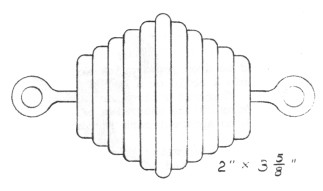
Dear Jack:
I am a new (senior citizen) insulator collector and would like to know
about an insulator I have.
It is about 2" across, 3-5/8" overall length and made of
composition. One end is marked "ELECTROSE", and the other end has two
partially legible patent dates as I've indicated on my very rough sketch
(redrawn above). Any information would be appreciated.
Winifred Reutter,
White River, S.D.
- - - - - - - - - -
Dear Winifred:
Your insulator is a strain made of composition material and was manufactured
by Electrose Manufacturing Co., Brooklyn, N.Y., president Louis Steinberger.
They cataloged hundreds of different insulators made of this composition
material, and many were based on patents by Steinberger. He had 88 patents (that
I know of) from 1903 to 1929 on insulators alone.
All patent dates are Tuesdays, so that lets us interpret the partially
legible markings on your specimen as follows: Nov 17, 1908, patent 904,370; July
6, 1909, patent 927,186.
Both of these are patent dates for strain insulators by Steinberger. He was
heavy on patents for strain types (the in-line varieties plus suspension types).
Many of the patents were for extremely impractical designs, but at least several
did have merit as evidenced by the items Electrose cataloged.
Electrose Mfg. Go. catalogings which include strain insulators similar to
yours are shown in the following: Crown Jewels, July 1974, page 24; Brown's
"Unique Collectible Insulators", page 68; Cranfill's "Dictionary
of...", pages 87-88.
I've always maintained it would be fun to make a specialized collection of
composition line insulators, but I don't know if anyone has taken me up on it
yet. It would be quite a challenge, since most varieties are quite scarce. It's
easy to see how most of these made were discarded long ago in favor of porcelain
insulators.
Jack
Dear Jack:
Enclosed are two pictures of a threadless porcelain I purchased in a small
flea market in Coudersport, Pa,, just a few miles from the New York state line.
It looks authentic to me. I am hoping that you can give me some info on this.
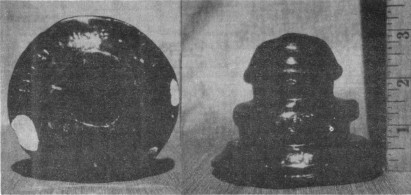
It is mint except for two small base chips as you can see in the photo (left
above). On the bottom of the insulator is the name FRED M. LOCKE and the date
1869. It looks like the maker used a pointed instrument to make (the markings)
before glazing and firing.
Could this have been an insulator personally made and signed by Fred H.
Locke? What is the value of this if it's authentic? It is really old and crude
looking, Hope you can help me out on this one.
Tom Stauffer,
Conestoga, PA
- - - - - - - - - -
Dear Tom:
This item obviously isn't a "regular insulator". It appears to be a
novelty creation on someone's part, and I know of no way to track down its
origin. It could be a very recent creation or a genuine artifact from old days,
and I'll comment on each possibility in turn.
Recent? Shades of HEM-42, I know of no old styles with a crown and square
wire groove like that. It would have been interesting for you to have strolled
back through the flea market an hour later to see if another one appeared on the
same table.
Old? I don't know when Fred M. Locke was born, but he couldn't have been more
than about 6 years old in 1869. It would make more logic if he was born in 1869.
Judging from many "Swiss Navy" creations I've seen as paper weights on
desks in porcelain insulator plants, it would not be implausible that this item
had a similar origin and purpose.
Sorry, but even if this was "authentic", I wouldn't have the
foggiest notion as to its value. I do believe no Locke specialist would chase
after this unless a connection with Fred M. Locke or some insulator factory
could be documented, and the chances of success in that are very remote. Any
pertinent info from readers is welcome.
Jack
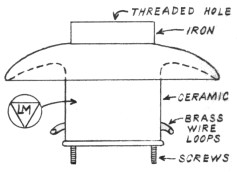
Dear Jack:
I am a collector of glass insulators for about 4 years and found this
streetlight in a utility dump. If possible, please send me information on it.
Would it be of value to collectors of ceramic insulators?
Barrett R. Milton
6105 Kilkenny Dr.
Crystal Lake, In. 60014
- - - - - - - - - -
Dear Barrett:
The marking on it indicates it was a product of Line Material Co., Milwaukee,
Wisconsin.
Other than the fact that some porcelain insulator collector may take a
fancy to the green porcelain portion of this (partial) street lamp assembly, I
don't think you'll get much interest in it as an insulator per se. If you can
trade it to another collector for some glass item you want, then it should make
two people happy.
Jack
Dear Jack:
... Also, what do you think of a U-298 white THOMAS with a brown wire groove?
It doesn't look like a metallic glaze for Radio-Quiet -- just a bright, light
brown glaze sprayed on. Bill Galloway got it for me at the Las Vegas show last
spring (1976). Can't figure why they would use just a plain brown instead of the
metallic like every one else.
Larry Thomas,
Oroville, Cal.
- - - - - - - - - -
Dear Larry:
I've seen these before, and they sure are pretty (and also the white J-D with
black groove, July 1975 CJ, page 21).
Regardless of its appearance, this is a conductive glaze for radio quieting.
I suspect Thomas first applied the conductive glaze to the groove and then
overcoated this with the regular white glaze; the RT glaze shows through and
permeates the white glaze when it's fired. If the regular glaze is applied first
and then the RT glaze added in the groove, it results in a mat glaze like the
Westinghouse RT insulators you see in the Oroville area.
Jack

Dear Jack:
... Also have a porcelain insulator which has me wondering a bit. It's a
U-152 dry process, with that grainy look just like the "G" embossed
porcelains. No markings are visible.
The insulator has an unglazed base, but it appears that it was fired upside
down. Also the top has seven small pieces of glaze broken out as if it had to be
ripped from whatever surface it was fired upon. The glaze itself is black, with
what appears to be copper flecks in it. These copper flecks are most common at
the trough between the skirt and the petticoat. The pin hole is also glazed
black.
Is this insulator an early, twice-fired type, or just a "victim" of
some funny insulator manufacturing process? If it's not an early type, why would
the insulator have a skirt rest, while from all I can tell it was fired upside
down? Also, what about the copper flecks in the glaze? Is this an attempt at
radio treating, or just incomplete or incorrect firing?
David Bethman
2410 H St.,
Bellingham, Wash. 98225
- - - - - - - - - -
Dear David:
Your description of the offbeat U-152 is quite clear, and I'll go along with
you on a few guesses about it.
It is probably a relatively early type because of being dry process, but not
necessarily because it does not have an extended petticoat for firing. Even some
very recent to current styles are fired skirt rest.
As you said, it was probably fired upside down, inadvertently I presume. The
porcelain factory dumps are full of all sorts of goofs such as that, but they
sometimes just shipped ones where the goof didn't affect its mechanical or
electrical functionability. This was true of the smaller companies in the past,
but the large surviving companies of this day will discard many perfectly
useable insulators because of the most minute flaws to protect their quality
reputation.
The flecks in the glaze may be "copper-appearing", but certainly
they are not copper. It is just some ingredient of the glaze which gives this
interesting irridescence. Also, insulators like this one used for signal
circuits needed no radio treatment, and the specimen was probably made long
before radio treatment entered the picture in the 1930's.
Jack
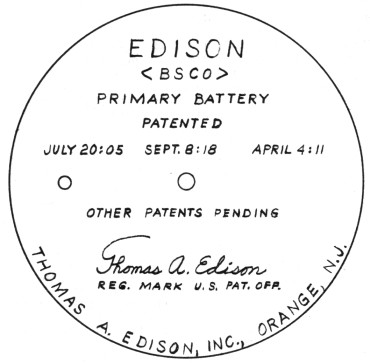
Hi Jack:
Recently I found this while crossing a track, pheasant hunting. It's 6-3/4
diameter, about 3/4" thick, white porcelain. I would like to know the value
and if it is a battery top. Also, do you know of anyone interested in it?
David Fisher,
Cedar Rapids, Iowa
- - - - - - - - -
Dear David:
Yes, this is a battery cap from a wet-type, closed-circuit primary battery.
The indicated manufacturer is Thomas A. Edison, Inc., Belmont Ave., Bloomfield
N.J. (factory location) and Orange, N.J. (main office location), established
1889. They used the following trademarks: "EDISON", "BSCO".
The president and general manager (about 1920) was Charles Edison.
Although I don't know the relationship, if any, there was also the Edison
Storage Battery Co., Orange, N.J., president Thomas A. Edison. After moving his
laboratories from Menlo Park to East Orange, N.J., Edison developed an extensive
group of manufacturing plants there.
There is no established value on such miscellaneous porcelain pieces
connected with electrical things, and it is a matter of "what you can get
for it in trade" if you find someone interested in obtaining it. The
complete battery would be a very collectible antique (not necessarily to
insulator collectors), but just the porcelain top cover by itself is a
different matter.
Jack
| 